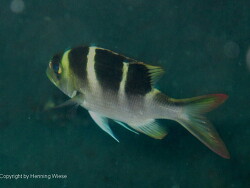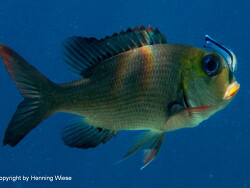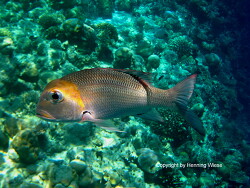Monotaxis grandoculis Bigeye Barenose, Bigeye Bream, Big-eye Bream, Bigeye Emperor, Big-eye Emperor, Big-eye Sea-bream, Grand-eyed Porgy Fish, Humpnose Bigeye Bream, Humpnose Big-eye Bream, Humpnose Big-eye Bream, Humpnose Sea-bream, Large-eye Bream, Large-eyed Sea Bream, Mu, Roundtooth Large-eye Bream, Bigeye Seabream
Monotaxis grandoculisis commonly referred to as Bigeye Barenose, Bigeye Bream, Big-eye Bream, Bigeye Emperor, Big-eye Emperor, Big-eye Sea-bream, Grand-eyed Porgy Fish, Humpnose Bigeye Bream, Humpnose Big-eye Bream, Humpnose Big-eye Bream, Humpnose Sea-bream, Large-eye Bream, Large-eyed Sea Bream, Mu, Roundtooth Large-eye Bream, Bigeye Seabream. Difficulty in the aquarium: suitable for large display tanks (public aquarium or zoo) only. Toxicity: Toxic hazard unknown.
Info
(Forsskål, 1775)
Monotaxis grandoculis, also called Humpnose Big-eye Bream, are widespread in the Indo-West and Central Pacific from the Red Sea and east coast of Africa, east to Hawaiii, Oceania and southeast along the northern coast of Australia back to Reunion and Madagascar. The northernmost locality is the southern tip of Japan.
The basic body color of the Humpnose Big-eye Bream is usually a little lighter blue-gray to almost white ventrally. His mouth (lips) can have almost all colors from yellow to pink depending on the origin and age. The eye area is often yellow to orange, the fins usually have no distinctive features and are usually transparent or show only a slight tint. Juvenile animals usually have three to four clearly visible, dark, often almost black crossbars. On the lower half of the body it is often much brighter than the upper. Adult animals have the opportunity to show this crossbar as well, but this is rarely seen.
Monotaxis grandoculis are usually found in reefs or near reefs, but is also found in lagoons on sandy bottom or even more rugged rocky areas. Most often we see them in smaller groups between 50-100 animals move around the reefs.
Humpnose Big-eye Bream is a "night hunter", his diet includes clams, brittle stars, sea urchins, crabs, polychaetes, sea squirts and sea cucumbers. They can reach a final length of up to 60 cm, most individuals are not larger than 40-45 cm.
Reports of ciguatera poisoning
Synonyms:
Lethrinus latidens Valenciennes, 1830
Monotaxis grandocculis (Forsskål, 1775)
Monotaxis grandoculus (Forsskål, 1775)
Monotaxis indica Anonymous [Bennett], 1830
Pagrus heterodon Bleeker, 1854
Sciaena grandoculis Forsskål, 1775
hma
am 25.04.10#1
Monotaxis grandoculis, auch Großaugenstraßenkehrer genannt, findet man weitverbreitet im Indo-West und Zentral-Pazifik vom Roten Meer und der Ostküste Afrikas östlich bis Hawaii, südöstlich bis Ozeanien sowie entlang der Nordküste Australiens wieder bis Reunion und Madagaskar. Der nördlichste Fundort ist die Südspitze Japans.
Die Körpergrundfärbung des Großaugenstraßenkehrer ist ein blau-grau meist etwas heller bis fast weiß ventral. Sein Maul (Lippen) kann von Gelb bis fast pink alle Farbvarianten aufweisen, je nach Herkunft und Alter. Die Augengegend ist oftmals gelb bis orange, die Flossen weisen meist kein markanten Merkmale auf und sind zumeist durchscheinend oder weisen nur eine geringe Färbung auf. Juvenile Tiere weisen meist 3 deutlich sichtbare, dunkle, meist fast schwarze, Querbalken auf wobei die untere Körperhälfte oftmals auch deutlich heller ist als die obere. Adulte Tiere haben offensichtlich die Möglichkeit Stimmungsabhängig diese Querbalken ebenfalls zu zeigen, dies ist aber eher selten der Fall.
Monotaxis grandoculis hält sich meist in Riff nähe oder in Riffen selbst auf wobei dies eher auf einzelnen Individuen zutrifft. Man findet sie auch in Lagunen über eher sandigem Untergrund aber auch in zerklüfteten steinigen Zonen. Am häufigsten sieht man sie in kleineren Gruppen zwischen 50 – 100 Tiere umd die Riffe ziehen.
Der Großaugenstraßenkehrer ist ein „Nachtjäger“ zu seinem Nahrungsspektrum gehören Muscheln, Schlangensterne, Seeigel, Krebse, Polychaeten, Seescheiden und Seegurken. Sie erreichen eine Endgröße von bis zu 60 cm, die meisten Individuen werden aber nicht größer als 40 – 45 cm.
Klasse : Actinopterygii
Familie: Lethrinidae
Genus : Monotaxis
Spezie : Monotaxis grandoculis
hma







 François Libert, Frankreich
François Libert, Frankreich




















